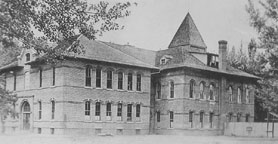 At Payette in 1886, local people on William Master's property, south of Main Street and Second Avenue South erected a small wooden school. Sagebrush was plentiful so it was used as fuel to keep the school. First election of school trustees was declared illegal, so on October 6, Peter Pence, W. H. Platt and John J. Reed were appointed trustees for one year of School District #32. Teacher salaries were paid by subscription from patrons. The next year, near trustees divided the school building into two parts and two teachers were hired, P. D. Barney and Mrs. Laura Ford. The school years were divided into a spring and a fall term. Barney taught four months, from November 1886 to March 1887, for a salary of $240. Ford received $160 for teaching the same length of time. The next spring, Miss. Beth Libbie was hired, but there was not enough money in the school treasury to pay her in full. After subscriptions were collected in the fall of 1887, she was paid the balance due of $8.24.
At Payette in 1886, local people on William Master's property, south of Main Street and Second Avenue South erected a small wooden school. Sagebrush was plentiful so it was used as fuel to keep the school. First election of school trustees was declared illegal, so on October 6, Peter Pence, W. H. Platt and John J. Reed were appointed trustees for one year of School District #32. Teacher salaries were paid by subscription from patrons. The next year, near trustees divided the school building into two parts and two teachers were hired, P. D. Barney and Mrs. Laura Ford. The school years were divided into a spring and a fall term. Barney taught four months, from November 1886 to March 1887, for a salary of $240. Ford received $160 for teaching the same length of time. The next spring, Miss. Beth Libbie was hired, but there was not enough money in the school treasury to pay her in full. After subscriptions were collected in the fall of 1887, she was paid the balance due of $8.24. In 1892, Professor M. F. Albert from Pennsylvania, was hired as principal of the high school until 1902. Professor J. R. Jimmerson and Miss Nellie Goodwin were teachers.
In 1892, Professor M. F. Albert from Pennsylvania, was hired as principal of the high school until 1902. Professor J. R. Jimmerson and Miss Nellie Goodwin were teachers.| Read More Articles by Ron Marlow | Learn More about Mr. Marlow |